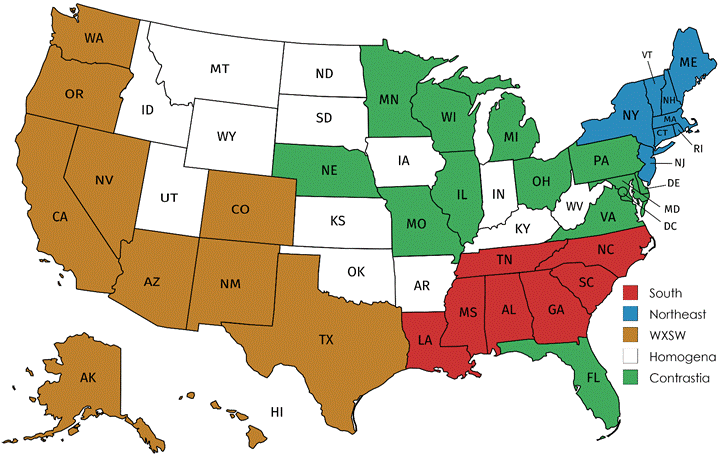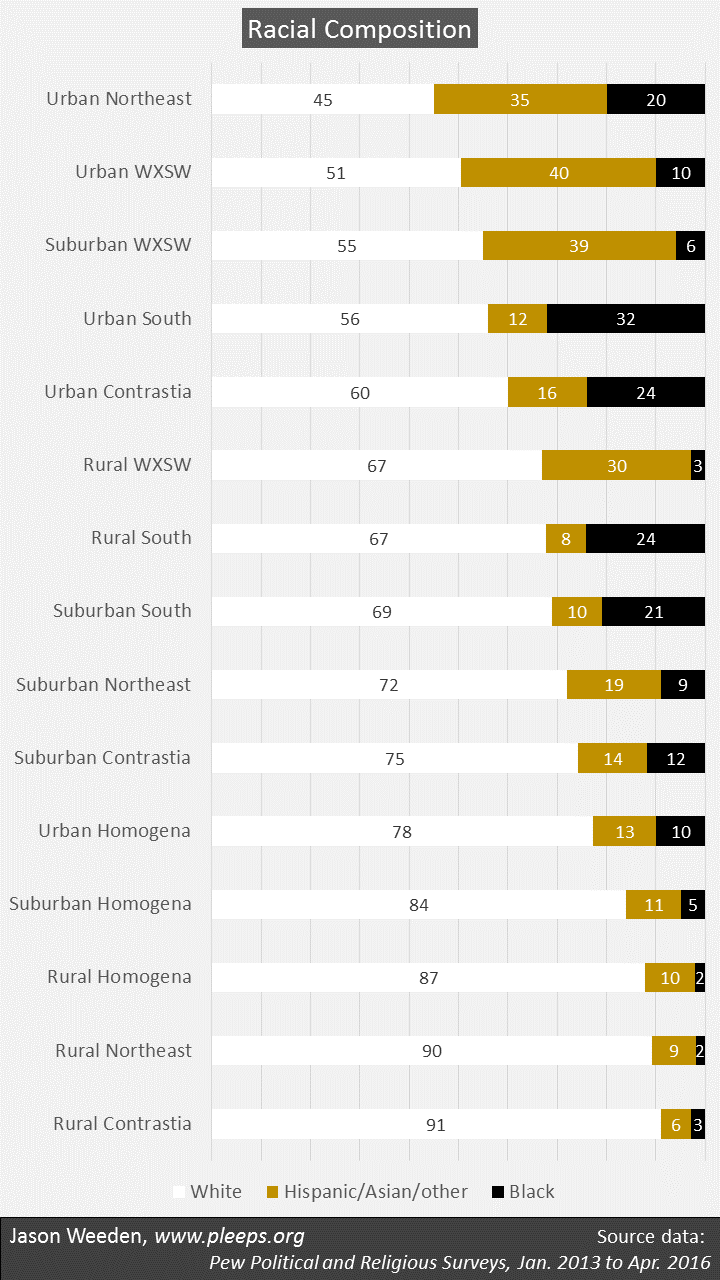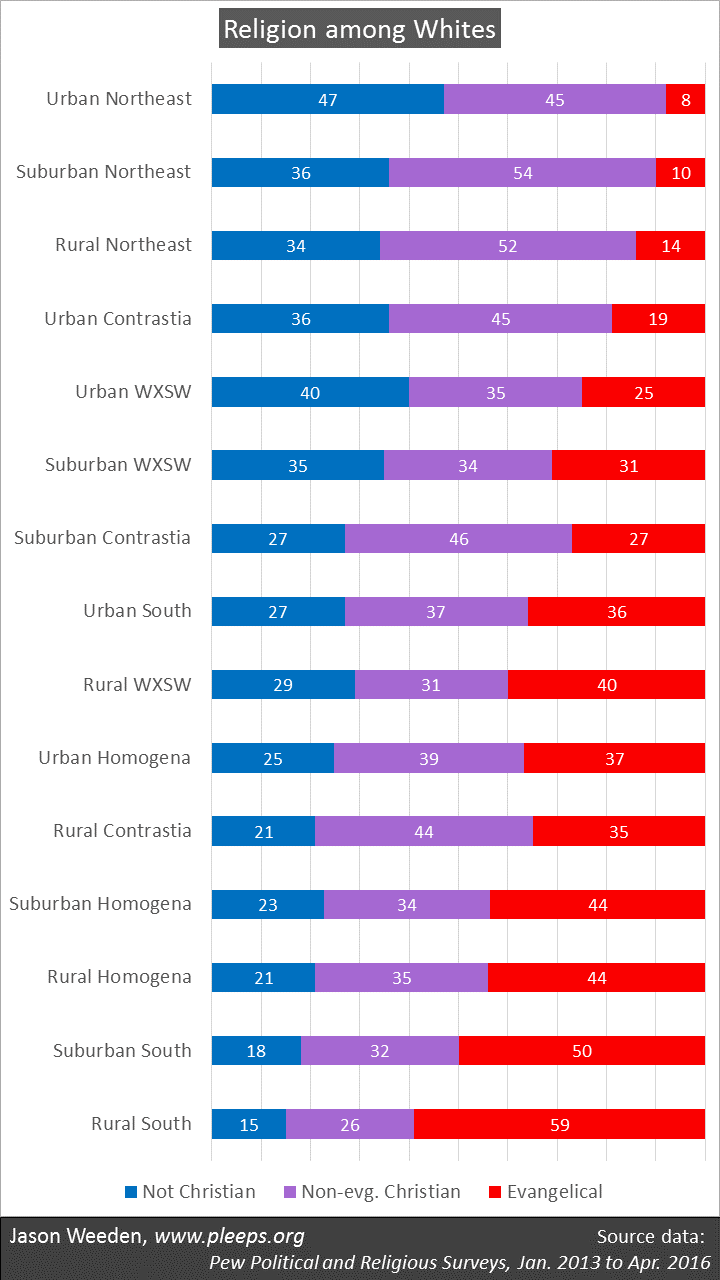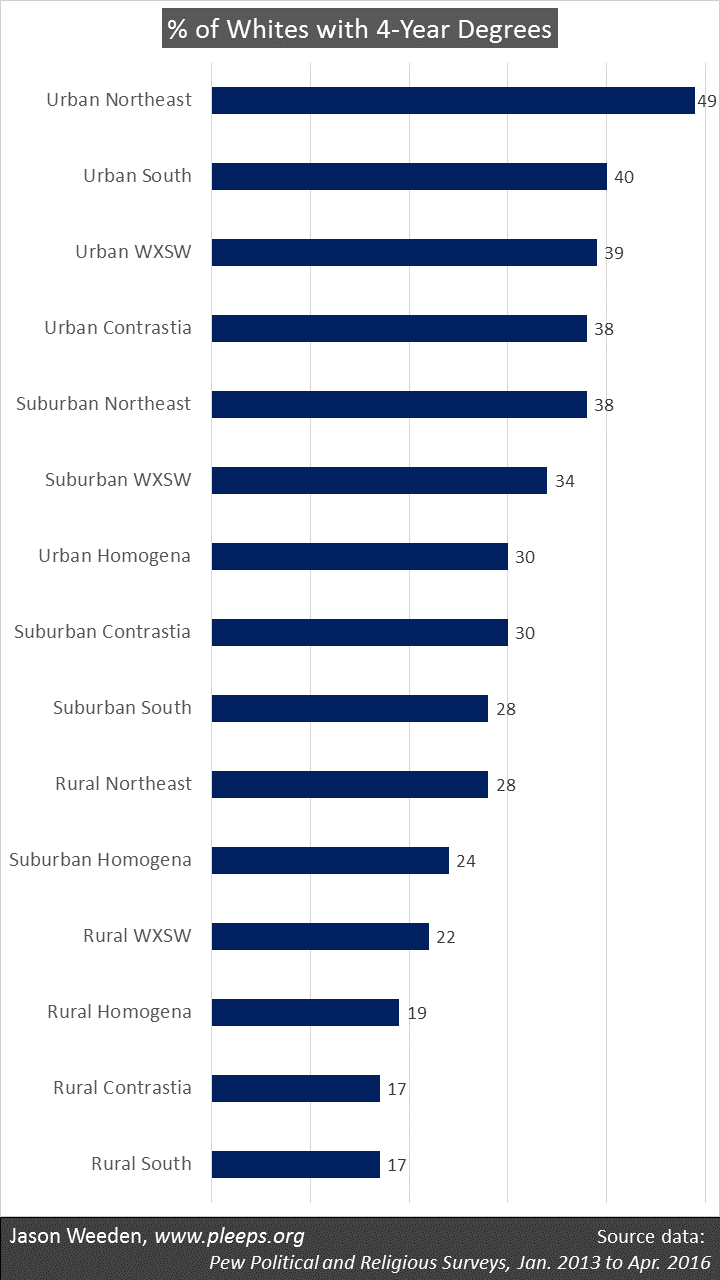One of the key things to watch over the next months and years is how Republicans advance the Bannon/Trump white nationalist agenda alongside the usual Republican economic agenda. Any sense that white nationalism was a mere election tool that would remain ultimately neglected in policymaking is being shaken by recent events; and while some congressional Republicans have raised objections, it doesn’t seem to be at a level that’s likely to translate into actual attempts to restrain the White House’s plans. Similarly, it’s still an open question whether the occasional elements of economic populism in Trump’s campaign will actually translate into White House resistance to congressional plans to combine large tax cuts for the wealthy with benefit cuts for poorer folks and seniors.
In this post, I’ll take a look at the demographics of views on white nationalist issues (immigration, race, Muslims, etc.) compared with views on rich/poor economics (government aid to the poor, the role of corporations and Wall Street, etc.). Which demographic groups are relatively aligned such that they tend to have consistently liberal or moderate or conservative views on both sets of issues on average? Which demographic groups are more likely to diverge such that they tend to hold views on one set that are to the left or right of their views on the other set?
This tells us something about the voters who might find different balances between white nationalism and economic conservatism either appealing or disappointing. Which in turn tells us something about how the parties in future elections might deal with different demographic slices.
I’ll give further details down below, but the short version is that I combined a large number of Pew datasets and created a couple of opinion mega-items, one of which combined lots of questions about immigration, race, Muslims, the Middle East, the military, and guns, and the other of which combined lots of items about government benefits, the poor, corporations, Social Security, and so on. I then took a set of demographic items (race, religion, gender, education, income, etc.) and began dividing and subdividing the sample, stopping when I reached 24 groups.
I’ve split the results into two charts to make the main point easier to spot. The first chart includes the 12 groups whose views on white nationalism and redistributive economics are in closest ideological alignment—that is, their liberalism or conservatism on one (on average, relative to the population as a whole) roughly matches their liberalism or conservatism on the other (again, on average, relative to the population as a whole). So, for example, group 1—non-white immigrants who’ve never been to college—are, on average, quite liberal on white nationalism and quite liberal on economic opinions. And group 12—white evangelical men without 4-year degrees and with household incomes above $40k—are quite conservative on both on average.
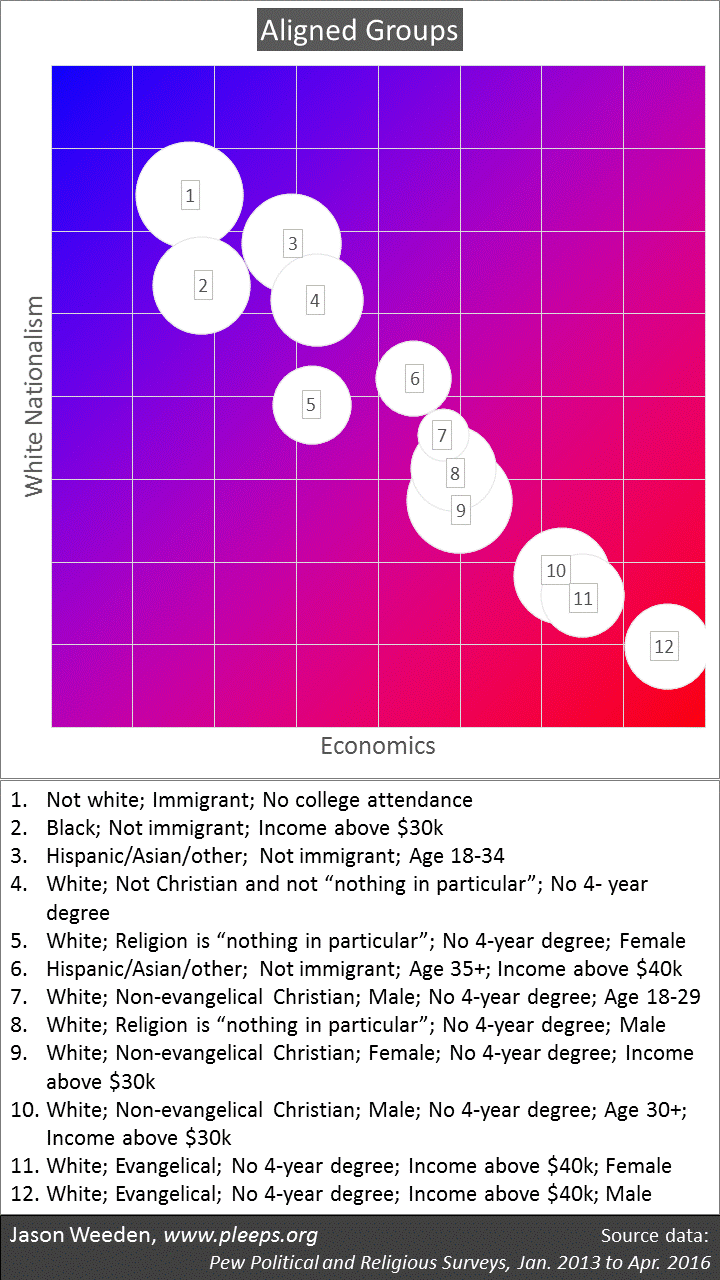
So those are the 12 groups that are most aligned. Now we get to the more interesting ones, the 12 groups that are most divergent. The chart above was pretty straightforward—the groups ran from most liberal in the upper-left corner to most conservative in the lower-right corner. The chart below is more complex because, for these divergent groups, now you’ve got to think about what it means to trend towards the upper-right corner and the lower-left corner. Because white nationalism runs from liberals at the top to conservatives at the bottom while economics runs from liberals on the left to conservatives on the right, the upper-right corner would hold a group that is liberal on white nationalism but conservative on economics (i.e., a kind of multiculturalist libertarianism) while the lower-left corner would hold a group that is conservative on white nationalism but liberal on economics (i.e., a kind of white nationalist populism).
As you can see in the chart below, these 12 divergent groups form two lines. One line (groups 1 through 6 on the chart below) includes groups that tend to be more conservative (or less liberal) on white nationalism than on economics. These are mostly groups that have less education and less income. The other line (groups 7 through 12 on the chart below) includes groups that tend to be more conservative (or less liberal) on economics than on white nationalism. These are mostly groups with college graduates.
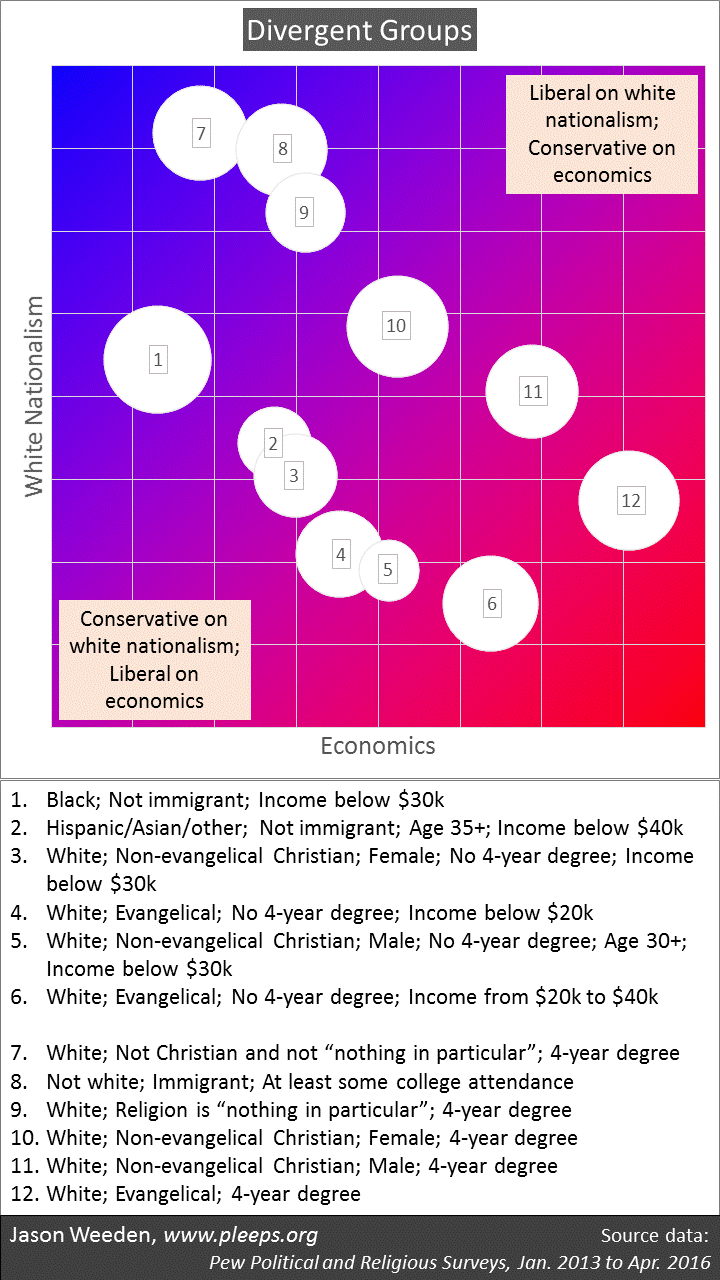
Here’s how to think about it. For these two opinion domains, race and religion operate as powerful drivers of liberal-conservative alignment. The conservatives tend to be white evangelicals and, to a lesser extent, white non-evangelical Christian men. White non-evangelical Christian women tend to be in the middle. And the liberals tend to be either white non-Christians or non-whites.
But then layered onto those powerful trends are the roles of education and income, which cause ideological divergence rather than ideological alignment. College-educated folks tend to be more liberal on white nationalism than on economics; poor folks tend to be more liberal on economics than on white nationalism.
These two patterns—the left-right ideological role of race and religion, and the divergence-driving role of socioeconomic status—combine to create the patterns in relative support for white nationalism and economic conservatism. For example, white evangelicals tend to be quite conservative on the whole. But, in addition, white evangelicals with 4-year degrees tend to be significantly more conservative on economics than on white nationalism, while white evangelicals who are poor tend to be significantly more conservative on white nationalism than on economics. (And, as shown on the first chart, the white evangelicals who tend to be about equally conservative on both are those who don’t have 4-year degrees, but who also aren’t poor.)
Other patterns are similar. Blacks who aren’t poor are liberal on both opinion domains, but poor blacks are significantly more liberal on economics than on white nationalism (e.g., they’re less supportive of immigration). Or, while white non-Christians without 4-year degrees tend to be on average roughly equivalently center-left on white nationalism and economics, degreed white non-Christians are significantly more liberal on white nationalism than on economics.
Electioneering
There’s already been a lot of early advice on how Democrats should make demographic adjustments to improve their performance in future elections. Much of this advice has encouraged Democrats to reconnect with low-education and low-income whites through an emphasis on economic populism and a de-emphasis on multiculturalism.
But the answer will depend to a degree on how Republicans manage to balance white nationalism against economic conservatism. If Republicans neglect white nationalism and instead focus on economic changes—cutting taxes for the wealthy, substantially diminishing ACA subsidies, making long-term cuts to elderly entitlements, and so on—then the downscale white strategy probably would make the most sense.
On the other hand, if Bannon/Trump manage to make policy changes that lean heavily towards white nationalism but not economic conservatism—banning Muslims, deporting DREAMers, building the wall, and so on, but not doing much to diminish current safety net programs—then the best new Democratic opportunities might come from college-educated whites.
The operative assumption has been that of course they’re going to pay lip-service to white nationalism while implementing substantially regressive economic changes. But the early days of the new Republican order have made this assumption less obvious. We’ll have to wait and see.
Some details on sample and measures
The sample I used for these analyses combines the 2014 Pew Religious Landscape sample with all publicly available Pew political samples from the beginning of 2013 to the most recently released. The aggregate sample is almost 98,000 folks (sweet!). Because not all opinion items were asked to all respondents, I combined whichever were available for a given respondent. Around 90,000 were asked at least one relevant white nationalist item and around 74,000 were asked at least one relevant economic opinion item. So, even when splitting up the sample into the 24 groups that I did, each group is still awfully big (around 1,500 to 5,000 each—super sweet!). I love Pew.
The white nationalism measure combines responses on 58 items. The main items (i.e., those asked to the most people in the sample) include: whether the growing population of immigrants is a change for the better or for the worse, whether immigrants strengthen the country, whether peace is best kept through military strength or diplomacy, whether undocumented immigrants should be allowed to stay in the country, whether racial discrimination is the main reason why many blacks can’t get ahead, whether overwhelming force is the best way to defeat terrorism, whether immigrants threaten American values, whether the country needs to continue making changes to give blacks equal rights, whether gun control is important, whether Islam encourages violence more than other religions, and so on.
The economic measure combines 29 items. The main ones include: whether government aid to the poor does more harm or more good, whether a smaller government with fewer services would be preferable, whether corporations make too much profit, whether poor people have easy or hard lives, whether the government should do more to help the needy, whether Wall Street helps or hurts the economy, whether the government should play a major role in helping people get out of poverty, whether the government should be responsible for making sure people have health care, whether Social Security benefits should be reduced, whether people are poor because of lack of effort, and so on.
So this was fun for me. I’ll keep going with similar analyses. Next up: Comparing views on white nationalism with views on lifestyle issues (same-sex marriage, abortion, marijuana legalization, etc.).

